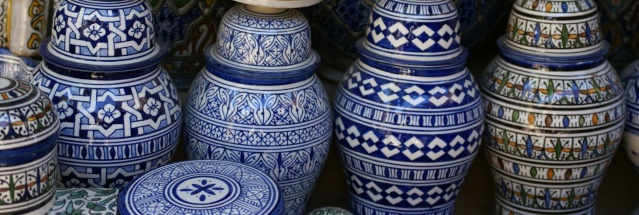
The Fassi craft a matter of centuries
The Moroccan craft dates back to more remote times of the kingdom. The Berbers, the original inhabitants of the area were the precursors of the Moroccan craft industry, particularly through the work of the wool (mats), iron and silver (jewelery), clay (various utensils) etc. The Arab conquerors of the land of Morocco, contributed to the evolution of the field of handicrafts by developing new forms such as copper work (various utensils), wood (various furniture), sorrel (various items), clay (pottery), etc.
In Fez, handicrafts represents the most important economic sector of the medina. It is indeed, the most represented professional category (more than one in three). In short, five leaders of 10 families belong to the body of artisans. The Fassi craft is characterized by its richness and diversity.
Indeed, the craft productions of the Fès-Boulemane region covering all industry sectors: (decorative and gift items, linens and tableware); furniture (wood furniture and wrought iron); jewelry (precious items, semi-precious and costume); clothing and accessories (fabrics and traditional clothing, slippers, scarves and leather goods); building (coating of floors, walls and ceilings, zellige, bejmat, carved wood and plaster). Besides the important place it occupies in the national and regional economies, crafts reflects the millennial wealth and know-how of Moroccan craftsmen masters.
It is positioned as the vector of the Moroccan identity as intangible cultural heritage as it has the distinction of carrying the artistic and cultural content of Morocco. Fez is positioned as artisanal capital of Morocco. Indeed, the craft is the international fame of the city of Fez. It is common knowledge that at Fez are the best craftsmanship and best workforce of Morocco.
Within the medina of Fez, craftsmanship is grouped by trades in different neighborhoods that bear the name of the activity (the area potters, blacksmiths district, the district of coppersmiths, etc.). This artisanal infrastructure is one of the most important features of the city. The Fassi craft since the 14th century known organizational structure as craft guilds. The corporation is an association of artisans gathered around the same trades in a pyramidal structure, headed by the rolled up, then maalem (the great master) and senai at the base of the pyramid there's the apprentice. The lamin symbolizes the wisest man of the corporation, it is somehow the delegate of the corporation he represents officially. The lamina is mainly responsible for adjudicating conflicts and resolving disputes between craftsmen and artisans and between customers, it was also responsible for controlling the quality of products and raw materials.




